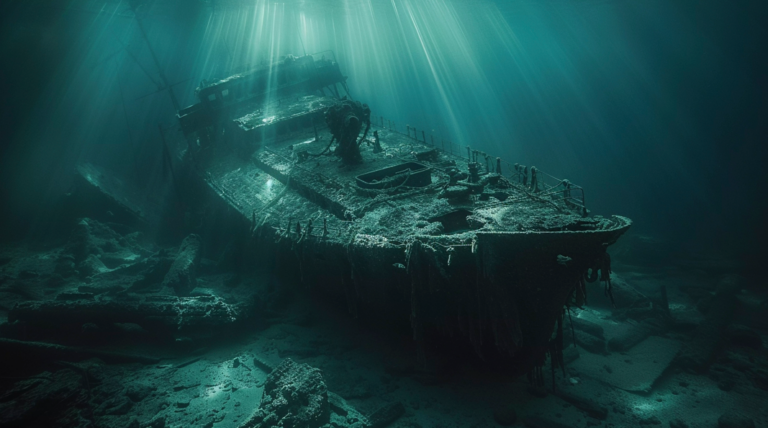The Titanic, which was depicted from the depths as a ghost ship preserved in digital amber, is now floating once more, but this time it is on terabytes of structured imagery rather than on water. A highly detailed 3D scan of the once-lost wreckage has been created thanks to the combined efforts of Atlantic Productions and Magellan Ltd. Not only does this high-resolution digital model depict the famous liner’s structure, but it also vividly depicts tragedy, resiliency, and sacrifice.
The scan, which was gathered over the course of a strenuous three-week expedition in 2022, consists of over 700,000 photos that have been stitched together to create a coherent reconstruction that enables the public and researchers to look at every rivet and railing. Without disturbing a single piece of debris, remote submersibles labored tirelessly 3,800 meters below the surface of the Atlantic, navigating one of the most hazardous underwater locations. The project makes sure that nothing important disappears into obscurity by mapping every square centimeter of the wreck, including its dispersed personal artifacts.
Titanic 3D Scan Key Information (Insertable WordPress Table)
| Feature | Description |
|---|---|
| Scan Initiated By | Magellan Ltd and Atlantic Productions |
| Completion Date | Summer 2022 |
| Data Volume | 16 terabytes, 700,000+ images |
| Technology Deployed | Robotic submersibles, photogrammetry, deep-sea mapping |
| Depth of Wreck | 3,800 meters (12,500 feet) |
| Area Covered | Approx. 15 square miles |
| Related Documentary | Titanic: The Digital Resurrection |
| Streaming Platforms | National Geographic, Hulu, Disney+ |
| Verified Source | BBC Science & Environment |
The degree of narrative correction introduced by this digital resurrection is what makes it especially advantageous. The Titanic has been romanticized or given simplified dramatizations in fictionalized accounts for decades. For example, First Officer William Murdoch was portrayed in James Cameron’s film as a panicked officer who shot at passengers before killing himself. However, the recently discovered digital evidence, which remarkably matches the sworn testimony of survivor Charles Lightoller, demonstrates that Murdoch was actually heroically launching a lifeboat when he was swept overboard.

Such disclosures are reputational redemptions as well as historical clarifications. They act as pertinent reminders that the perspective of hindsight, especially when influenced by entertainment, frequently distorts actual human behavior. A significantly better version of history—one based on forensic accuracy rather than narrative convenience—is made possible by these digital corrections.
What the scan shows about the ship’s internal workings in its last hours may be even more fascinating. Long-standing eyewitness accounts of 35 engineers remaining below deck, working under tremendous pressure, were confirmed by researchers who discovered that a critical steam valve had been left open in the boiler room. Maintaining electricity long enough to give passengers light while they fled was their singular but crucial mission. These men were so dependable in their work that they kept working almost until the ship vanished under the waves.
When compared to contemporary frontline workers—those who remain behind during international emergencies while others evacuate—this act of sacrifice becomes all the more poignant. These instances have a strikingly potent symbolism that emphasizes the human desire to defend others, even at one’s own risk. The Titanic 3D scan serves as both a technological achievement and a human archive by highlighting such details.
The debris field strewn about the wreck is another noteworthy discovery. Items that provide physical reminders of lives past, like leather shoes, gold coins, ornamental carvings, and sealed champagne bottles, are eerily intact. By linking these artifacts to specific travelers, Yasmin Khan, a historian at the University of Oxford, has been giving names that are frequently hidden beneath statistics some form. This degree of narrative makes it abundantly evident that history is composed of minor, frequently disregarded details rather than just significant occurrences.
The scan’s integration with platforms for entertainment and public education is one of its most inventive features. Educational institutions can now let students virtually explore the Titanic, much like they would if they were visiting a preserved site, thanks to augmented reality tools. Speaking about this innovation, James Cameron described it as “a revolution in maritime research,” pointing out that the level of detail fidelity greatly exceeds what was feasible in his film.
However, not only directors and researchers are paying attention. In a recent private preview, actor Leonardo DiCaprio, who played Jack Dawson in the 1997 movie, interacted with the scan. He reflected on how incredibly immersive the digital environment felt, comparing it to walking through the memory of something vast and lost, and called the experience “profoundly moving.”
It is impossible to overestimate the social and cultural impact of such a scan. The Titanic 3D scan is especially realistic in a time when artificial reality and simulation are the norm. Its goals are to preserve, inform, and correct rather than to amuse. This digital twin serves as the final trustworthy witness as deterioration threatens to destroy the physical remains. Its testimony is both detailed and comprehensive, just like that of any good witness.
The scan preserves structural details and respects emotional truths by freezing the shipwreck in its current state. It enables the 1,500 lives lost to be remembered, reevaluated, and—possibly most importantly—rehumanized. That emotional clarity, which was attained through digital precision rather than dramatization, is what makes this endeavor so vitally significant.
